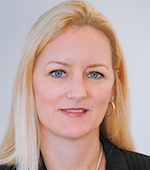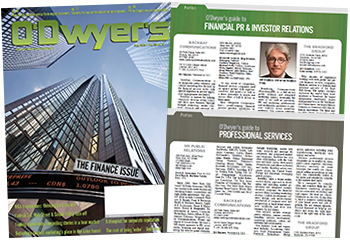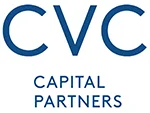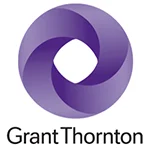 Valerie Christopherson Valerie Christopherson |
Every seasoned and successful investor lives by the mantra “Sell high, buy low,” yet few among the uninitiated are brave enough to follow this sage advice. It’s understandable, given that many of us find the stock market and investment strategies complex and hard to grasp.
At the same time, it’s ironic considering our country’s history of recessions, which have occurred with surprising regularity since 1797 when land speculation in the New World caused widespread panic. Expected though excruciating, recessions are, in fact, far more common to the cycle of business than the current economic climate we’ve been enjoying since June 2009, at which point recovery began after the market bottomed out in 2008.
 |
| This article is featured in O'Dwyer's Aug. '19 Financial PR/IR & Prof. Svcs. PR Magazine. |
Alas, true to Isaac Newton’s law of motion, what goes up must come down. And when it does, it’s only natural that some businesses and entrepreneurs will run for cover while others embrace a crash or a market correction like a cold shower in the desert at high noon.
Recognizing the opportunity for new beginnings and different approaches often require a compelling brand story and balanced perspective in how peaks and valleys are viewed. Businesses that panic at the sight of a market sloping downward tend to spin their wheels, with their thoughts tied up by fear. On the other hand, companies that take the valleys and peaks in stride strategically use slow times to tap into their creative resources, designing new products or services and crafting targeting marketing and publicity campaigns that increase engagement with an existing customer base and grab the attention of new audiences. Recent history provides us with a plethora of examples of companies that took on the bear market of 2008—the worst recession since the Great Depression—and thrived. Here’s how they did it.
Clear messaging that cuts to the chase
Plain and simple, Groupon entered a slumping economy in November 2008 with an irresistible offer: Deep-discounted goods and services. With clear messaging and an easy-to-navigate website, it served the goal of businesses to keep moving products while giving consumers a needed financial break. Word of mouth spread quickly about the company that offered local deals daily, and in just two years Groupon settled into 35 countries and 300 markets, with an annual profit of $500 million.
Building a brand identity that lives up to its customer promise
At the peak of the recession in 2009, Netflix did next to the impossible by gaining three million new subscribers, all while a video rental giant lay dying. Its choice of TV and movie streaming plans and disc delivery services allowed subscribers to temporarily forget their financial worries and watch unlimited hours of entertainment a month at a bargain price. With a great brand identity that lived up to its customer promise, Netflix continued on an upward trajectory and today retains more than 148 million subscribers globally.
Reaching audiences beyond traditional channels
The wildly popular coffee retailer Starbucks, founded in 1971, was on the fast track, opening, on average, two stores per day between 1987 and 2007, at which time it hit a virtual wall. Stepping back, the company shifted its focus away from bureaucracy and realigned its operations to connect emotionally with customers by engaging and campaigning through new social media channels including Facebook, Instagram and Twitter. Customers were able to share their views and offer opinions on products, services, store aesthetics and corporate social responsibility, many of which were taken into account and became the new foundation of its reformed brand: an altruistic, community builder that cares for the environment.
Along with the Amazons, Fords, Dominos and other mavericks that survived and thrived through the shrinking economy, tenacious brand builders—large and small—could be found in every industry, even our own. After working in public relations for 10 years, I founded Global Results Communications in 2005 to serve the growing high-tech sector, which included the consumer electronics and mobile industries. It was a seamless push-up and over the hill primarily because of the kinds of clients we attracted. They were innovative, courageous entrepreneurs charting new courses and mainstay organizations brazenly moving forward despite the obvious obstacles. Trusting our instincts and playing to our strengths, we leveraged the fear permeating the market and positioned them as confident and courageous market leaders. And it paid off.
Telcordia Technologies, one of GRC’s earliest clients brought on in 2006, was at the time headquartered in Piscataway, New Jersey. Guiding the company through the downturn and beyond, Telcordia was generating revenues of $739 million by 2011. In an all-cash transaction, on a cash and debt-free basis, it was successfully acquired by Ericsson for $1.15 billion in 2012 and became a wholly-owned subsidiary of Ericsson. Still part of the GRC portfolio, the company was rebranded as iconectiv in 2013. Today, iconectiv is an invaluable client and telecom powerhouse that provides network and operations management, numbering, registry and fraud preventions solutions to the telecommunications industry.
Nuance Communications, a pioneer in voice recognition and conversational AI technologies for the healthcare, banking, enterprise and automotive markets, has been a GRC client since 2006, at which time it was a $600 million company. With continuous placements including interviews and features in top-tier media such as National Public Radio, Fast Company, New York Times, Wall Street Journal and Mashable among others, Nuance became a trusted source for the press corps and a recognized industry thought leader. By 2018, it had grown to a $2 billion company on the cutting edge of the most advanced biometrics and voice-assisted solutions for fraud prevention, as well as an automotive visionary helping to design the cockpit of the future for the world’s largest carmakers.
Along with world-class clients across the globe, GRC has continued to expand to include all vertical markets touched by technology including healthtech, healthcare, IoT, automotive, retail, financial services, greentech, advertising and marketing, social and many more.
While evolving our scope of capabilities to include today’s most advanced digital and social mediums, we remain not only committed to staying ahead of the technology curve but also focused on the fact that telling a compelling story transcends any market, bear or bull.
***
Valerie Christopherson is Founder and CEO of Global Results Communications.


 Teneo is handling the initial public offering of CVC Capital Partners, one of Europe’s largest private equity firms with nearly $200B in assets under management.
Teneo is handling the initial public offering of CVC Capital Partners, one of Europe’s largest private equity firms with nearly $200B in assets under management. Brunswick Group represents Endeavor Group Holdings as it agrees to go private via its acquisition by Silver Lake technology investment firm, which is handled by Edelman Smithfield.
Brunswick Group represents Endeavor Group Holdings as it agrees to go private via its acquisition by Silver Lake technology investment firm, which is handled by Edelman Smithfield. Tod Donhauser, a nine-year veteran of Edelman, has joined H/Advisors Abernathy as managing director and head of its San Francisco office.
Tod Donhauser, a nine-year veteran of Edelman, has joined H/Advisors Abernathy as managing director and head of its San Francisco office. Intelligent Group Ltd, a Hong Kong-based financial PR firm, has priced its initial public offering of 1.9M shares at $4, which is the low end of the $4 to $5 range.
Intelligent Group Ltd, a Hong Kong-based financial PR firm, has priced its initial public offering of 1.9M shares at $4, which is the low end of the $4 to $5 range. Kekst CNC represents Grant Thornton as it sells a majority stake in its US arm to New Mountain Capital, which relies on Goldin Solutions, in what is billed as the largest PE investment in the accounting and advisory sector.
Kekst CNC represents Grant Thornton as it sells a majority stake in its US arm to New Mountain Capital, which relies on Goldin Solutions, in what is billed as the largest PE investment in the accounting and advisory sector.


 Have a comment? Send it to
Have a comment? Send it to 
No comments have been submitted for this story yet.